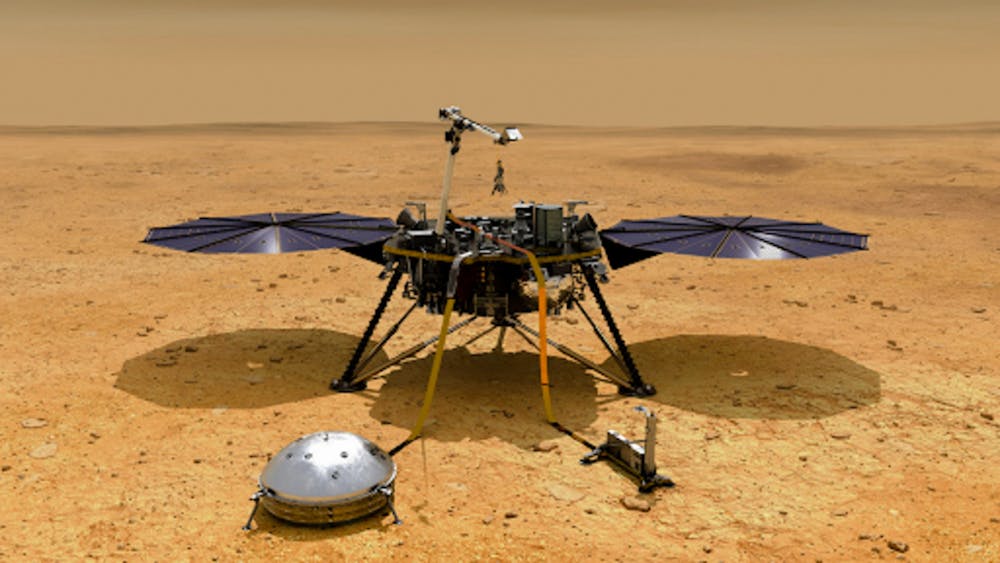For the first time, researchers have detected seismic waves from four impacts — the collision of astronomical objects — on the surface of Mars. They published their findings in a Nature Geoscience paper co-authored by Ingrid Daubar, assistant professor of Earth, environmental and planetary sciences.
The NASA InSight lander launched in May 2018 and landed on Mars in November of the same year. Daubar started working on the InSight lander mission in 2015 as a postdoc at the NASA Jet Propulsion Laboratory in Pasadena, Calif., where she helped with the landing site selection and safety certification.
The lander is equipped with two cameras, which allow it to take photos of the landscape, sky and Martian clouds, Daubar said. Additionally, it carries several seismometers, which are used to measure the vibrations of the ground at different frequencies and in different directions during quakes on Mars, she added. InSight is unique compared to other Mars landers in that it stays in one place, Daubar explained.
The lander also measures vibrations in the air, called acoustic waves, which help scientists learn more about the atmospheric structure of Mars, Daubar said. Because the speed at which sound travels is proportional to the density of the material it travels through, seismic waves moving through Mars’ dense crust are much faster than the acoustic waves in the atmosphere. Both provide the lander with important information.
In this study, researchers combined InSight’s seismic data with images gathered from the Mars Reconnaissance Orbiter, allowing them to determine which seismic signals were created by impacts. This is the first time scientists have been able to collect seismic waves specifically from an impact.
Although InSight has detected nearly 1,300 quakes since its landing, scientists were not able to determine the epicenter of any of the quakes, said Victor Tsai, associate professor of earth, environmental and planetary sciences. With only seismic data, “it is very hard to tell what some of these signals are due to, where they are, how they get excited and how big they are compared to other events that we see,” Tsai added.
Using InSight data, “we can pinpoint where those new craters are and take away a lot of the uncertainties in the estimates and the analysis of that seismic data,” Daubar explained.
“Once we know what one specific signal looks like, … it is easier to understand what all the other signals are,” Tsai said. “It gives some ground truth for how to interpret all other data.” This will serve as “a useful tie point to how all other data can be interpreted from the Insight mission,” he added.
According to Daubar, studying the impacts and subsequent craters on Mars is important in understanding other aspects of the Red Planet.
“We use the density of craters on planetary surfaces to estimate their age,” Daubar said. This is “because the older (the planet) is, the more craters it's going to have.”
“We have to calibrate what we think the frequency of impacts was over time.” By measuring the frequency of crater impacts now, scientists can understand their past frequency, Daubar added
Studying craters is also useful in terms of hazard avoidance. “We are obviously a little bit worried about things hitting the Earth. So, if we understand more about what is hitting Mars, that can help us understand how many things are out there, how big they are and what damage they could do,” Daubar said.
The impacts dig up material under the surface of Mars that has not been exposed for millions of years, Daubar said, which allows scientists to study the structure of Mars beneath the surface.
We may be able to understand Earth’s history better, Dauber added. “We have a really great seismic network on Earth,” she said, which has allowed researchers to better understand the interior structure and evolution of Earth. “The more we can learn about Mars in the same way, the more it lets us compare the Earth and Mars because they are different in really interesting ways, and we are not 100% sure why.”
According to Jim Head, professor of planetary geoscience, researching the geological record of Earth’s history allows us to better understand the planet’s future. “(Earth’s) constantly overturning due to plate tectonics and weathering, so only a very small percentage is left from the first half of solar system history. So the Moon and Mars and other planets give us clues to what was going on,” at that time, he added.
Knowing more about the conditions on Mars will tell us how similar conditions will affect Earth in the future.
“InSight is near the end of its life,” Daubar said. The lander is solar-powered and dust has been accumulating from the Martian atmosphere and trickling down on the solar panels. Unless a big gust of wind cleans up the solar arrays, “we’re probably looking at just a month or two more of operations on the surface,” she added.
While InSight may soon be inoperative, the researchers have only begun to understand the data it’s collected. With these new measurements from surface impacts, the researchers can “look back at all the previous data that we’ve collected in a new light. We can go back through this big catalog of data for the past four years and maybe see if anything else shares (the) characteristics” of the crater data, Daubar said.
Other missions to Mars “have kind of scratched the surface of Mars, but InSight is really delving into the whole interior of the planet,” Daubar added.





